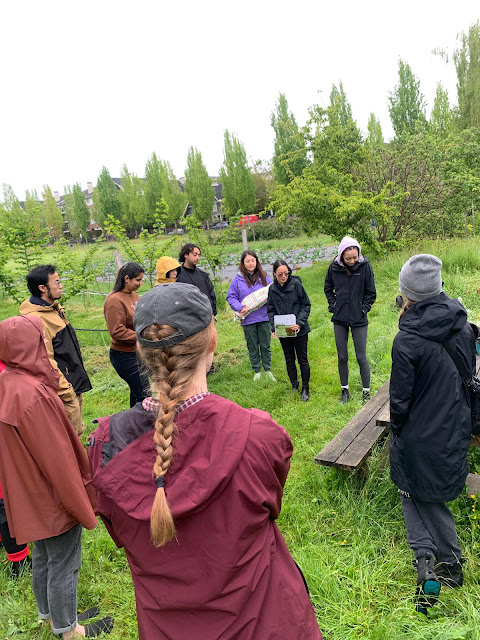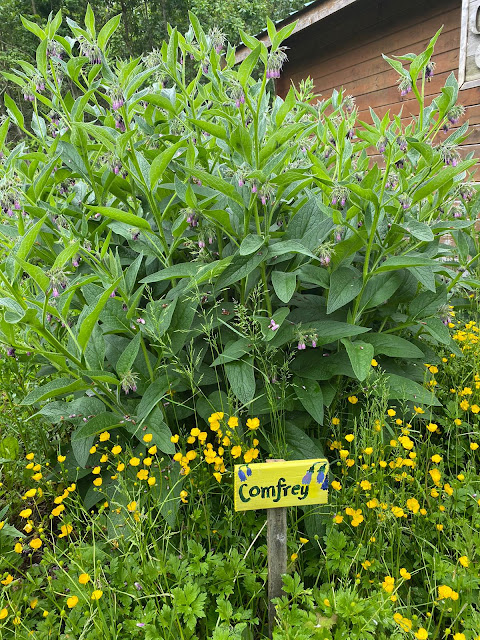Food Forest (Sally): After introductions and a land acknowledgement, we kicked off our workshop with a discussion about permaculture and an exploration of the food forest side of the Orchard Garden. There were some really interesting ideas shared about the meaning of permaculture and how humans can involve themselves in the cycles of nature. We discussed what kind of plants are found in the food forest, and how it will be able to grow into a more self-sufficient ecosystem. Then, with a few minutes to wander freely, the workshop participants took a closer look at the different plants in the food forest, seeing what they recognized and what other forms of life were found there; we discussed the presence of slugs, and how they might be seen as pests in a typical garden if they munched on the vegetables you’re trying to grow, but here, their role as decomposers make them welcome and essential. As much as human involvement is necessary here, the goal of a food forest seems to me to be to be able to back off once it’s established and let those natural cycles perpetuate. We can shape and influence nature without fundamentally changing it, and I think that’s a really wonderful reminder that humans are in fact part of nature.
Orchard Garden (Ian): After the walk through the food forest we moved onto the more traditional side of the Garden. With a startin off point of comparison to the food forest, we talked about how this area is more manicured and what you’d expect of traditional (in the western lens of farming) gardening. With this, the plants which we would specifically be looking at were pointed out, and as part of the workshop, we had the option to make signs for them. What you actually do when creating signage and marking a garden is important. How we went about looking at this side of the space was more than just thinking of which plant on the list we wanted, we want to create a representation of how we see the plant. When speaking about the space we also spoke about how the ground has what we call “weeds” which needed to be removed, and how the plants in the space work efficiently but need to be tended to. I shared how the mindset of a garden like this can shift though, bringing up Dr. Susan Gerofsky’s outlook, calling these unexpected plants “volunteers”. How we think and imagine a space, and conceptualize it (including our language around it of course!) heavily affects how the space is treated and used by others and ourselves. Representations of ourselves and the way we navigate the world physically, mentally, spiritually, and communally all culminate in the spaces around us. Cultivating and growing more wholesome and inviting environments in these ways was important, as each action and choice we make today (and everyday) determines the type of person and the type of world we want in the future.
Dandelions (Lorilie): We had a wonderful discussion about dandelions and uses as both a food and as a medicine. We posed the question “What do you consider to be a weed” and we had a valuable discussion about the negative connotation that the word “weed” has. Dandelions can be used as food and the flowers are very sweet while the leaves and roots are quite bitter. They can be used in tea and as a type of “coffee” (decaf) using the leaves and the roots. The leaves are also really good replacements for arugula or spinach on pizza! I too considered dandelions as weeds before doing research for the handout. Although dandelions do match with the definition of a weed, "a plant that is growing where it is not wanted", it has many uses to the point that a lot of various cultures and scientists consider dandelions to be an herb instead of a weed! I had a really interesting discussion with one of the attendees at today’s workshop and we discussed how a lot of things we know today are of a "one way street" POV which science is generally viewed as. A lot of my students see science from a Western lens but there are multiple ways to see science. I think it would be great to continue to teach my students the concept of Two-Eyed Seeing which is an Indigenous perspective on incorporating Western and Indigenous sciences together. I feel that it is really important to keep practicing this concept, even outside of science, because learning to acknowledge other perspectives and ideas is such a fundamental aspect of love and respect for one another.

As we were painting the signs it made me reflect back to the other day when we were putting the signs together for this workshop. The wood was left over wood that we found around the Orchard garden, along with the paint that had been lying around from previous years in the shed. The nails that we needed to put the wood together to construct the signs were nails that Ian had already. All of these materials that we used to create these signs were already things we all had (we never bought anything new). In this aspect, learning to be sustainable by reusing materials or repurposing materials for different uses is so special and useful because it helps limit the amount of resources we are using to create something new. I taught this concept to my Environmental Science 12 class during long practicum and I'll continue to teach this because I think it is really important to consider where we get our things from and how much time and energy it takes for natural things (e.g. trees growing for our wood) to become products that we use. By reusing and repurposing, it'll help the planet a little bit more and limit the amount of waste we produce.
Braiding (Nicole): To begin the latter half of the workshop, we segued nicely between talking about the anatomy of dandelions, to presenting the collection of dandelion stems that we had picked earlier during our CFE. The stems had been allowed to dry throughout our 3-weeks in the garden and were ready for braiding! Then, we welcomed a short break and a breather from all of the information, to explore and appreciate the garden. Everyone was invited to spend 20 minutes to search and gather new dandelion stems for future braiders, explore the garden with their senses, take a moment to breathe at the end of their week, relax and chat while enjoying refreshments, or all of the above! When we returned together, some had shared that they appreciated the moment to break and we chatted about the significance of taking mindful moments to pause and reflect, breathe, or appreciate the environment around you. We continued to discuss braiding and coincidentally many of the individuals attending the workshop had braids in their hair to showcase as examples! We branched into groups to discuss what we thought braiding of multiple materials may symbolize or represent and then shared as a large group. We discussed that braiding can symbolize the weaving of different ideas, perspectives, strengths, and skills that come together in complementary unity and harmony. Where one strand may be easily broken on its own, yet multiple strands woven together present strong yet flexible bonds and connections. Together, we listened to the introduction of Braiding Sweetgrass by Dr. Robin Wall Kimmerer, where she describes the act of braiding, “Of course you can do it by yourself… but the sweetest way is to have someone else hold the end so that you pull gently against each other, all the while leaning in, head to head, chatting and laughing, watching each other’s hands. One holding steady while the other shifts the slim bundles over one another each in its turn. Linked by sweetgrass, there is reciprocity between you. Linked by sweetgrass, the holder as vital as the braider.” In our small groups, we had the opportunity to discuss how the felt-experience of braiding, or any activity, changes when working collaboratively with others compared to working alone, and what other examples of reciprocity we see or experience in life. Each group participated in enriched discussions sharing ideas, experiences, and stories together. Wonderful examples of reciprocity were presented in the large group, like raising Mason bees, slugs and snails in the garden, and giving back to nature, and we acknowledged and appreciated everyone’s participation in the discussions. The rest of the workshop was devoted to braiding dandelion stems (tutorials and examples provided as guides) and painting signs for the garden! Everyone seemed to be so immersed in the activities, the hour flew right by! Fantastic signs were designed for various plants in the garden and upon installation, they added the perfect splashes of colourful information to it. Our goal was to create signs as opportunities for visitors to be empowered with knowledge of the plant residents of the garden and appreciate what was growing. It was a wonderful feeling to have everyone engaged in such a creative and collective activity together. The perfect blend of meditative artwork in such a calm and enriching environment. Truly a wonderful afternoon.




No comments:
Post a Comment